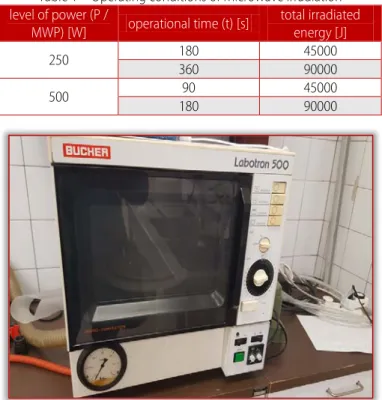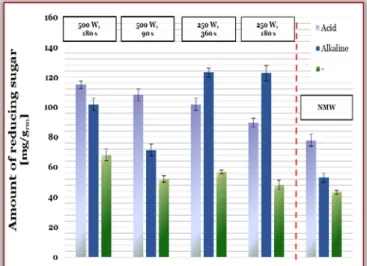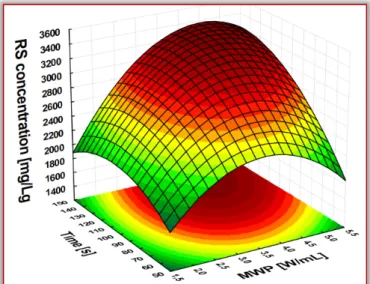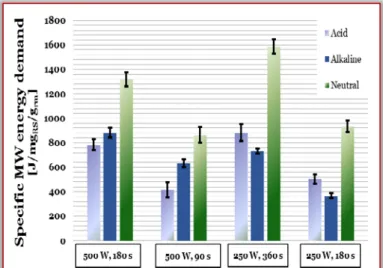1.Zoltán JÁKÓI, 1.Anna SZABÓ, 2.Andrea VÁGVÖLGYI,
1.Cecilia HODÚR, 1.Sándor BESZÉDES
APPLICABILITY OF MICROWAVE IRRADIATION FOR ENHANCED BIODEGRADABILITY OF TOBACCO BIOMASS
1.University of Szeged, Faculty of Engineering, Institute of Process Engineering, Moszkvai krt. 9, Szeged, HUNGARY
2.University of Sopron, Faculty of Forestry, Institute of Forestry and Environmental Techniques, Bajcsy-Zsilinszky u.4, Sopron, HUNGARY
Abstract: The aim of our research was to investigate the effects of microwave (MW) irradiation on the enzymatic degradation of the lignocellulose content of tobacco-originated biomass. Mixture of different parts of by-product tobacco plants in an aqueous suspension of 10 (m/m)% were used for the experiments, and MW-pretreatment was applied at two different levels of energy density. The effects of the chemical (acid/alkaline) conditions during the MW irradiation were also investigated. To evaluate the efficiency of the applied pre-treatment methods the concentration of produced reducing sugar was measured right after the treatment processes, and after the enzymatic hydrolysis stage, as well. In order to characterize the energy efficiency of pretreatments, the specific energy demand at each experimental setup was evaluated.
Keywords: microwave, pre-treatment, lignocellulose, biomass, hydrolysis
INTRODUCTION
Nowadays the decreasing of available and economically exploitable fossil energy sources presents a great global problem to be solved, regarding that the energy demand of the Earth has been increasing since the 90s. In order to support the sustainable development and the energy demand of the world, the utilization and use of alternative and renewable energy sources should be undoubtedly taken into consideration.
Recently, lignocellulosic biomass (LCB) has gained greater and greater attention as a promising source of energy due to its low cost and great availability, since it is presented in an excessive amount worldwide. Because of this, LCB, especially if produced as waste stream in agriculture or food industry, presents a good alternative for the energy sector and the food and chemical industry. Biomass- based energy production technically covers the direct utilization of solar energy after the transformation of biological systems. The energetic usage of biomass is „CO2 neutral”, which means that during the utilization as fuel does not produce more CO2 than plants can utilize during photosynthesis (Matthews, 2008).
Commonly utilized bioethanol is produced from sugar or starch with fermentation by yeast or continuous distillation. There are several types of bioenergy plants for producing bioethanol like sugar-beet, wheat, corn in Europe, corn and wheat in North America and sugar-cane in South America. Besides these, raw materials with high cellulose or lignocellulose content, e.g. corn- stalk, waste of wood industry or sorghum have also been used frequently for this purpose recently (Gnansounonou et al., 2005).
The method of bioethanol production can vary according to the type of the bioenergy plant: sugar extraction and fermentation, hydrolysis and fermentation of starch, and with the – possibly enzymatic – hydrolysis and fermentation of cellulose (Grey et al., 2006). In terms of bioethanol production, there is also a great potential in the cellulose-containing wastes of several different industries. On the other hand, the utilization of cellulose for energetic purposes faces difficulties, due to the rigid and resistant
molecular structure of cellulose fibers, which makes biodegradation problematic. However, implementing a one or two-step pre- treatment process (e.g. chemical, physical or physicochemical) prior to the enzymatic digestion, might enhance the efficiency of the whole process, making cellulose-based materials easier utilizable for energetic purposes.
The electromagnetic radiation (EM) is divided into seven regions.
One of them is the range of microwaves (MW), which falls in the interval of the EM spectrum between radiofrequency and infrared light. Its wavelength is from about 1 cm to 1 m, which corresponds to the frequency range of 30 GHz up to 300MHz (Metaxas and Meredith, 1993). Some of the doubtless advantages of microwave irradiation are the capability of more uniform heating in the penetration depth of the irradiated material compared to conventional heating methods, the ability of volumetric heating, and the high energy density – all of which shorten the time demand of operations. There are two main phenomena that contribute to the transformation of microwave energy into heat: ionic conduction, and dipole rotation. Ionic conduction is significant when the MW irradiated solution contains diluted and migratable ions, and dipole rotation is considerable when the material contains polarizable molecules.
Some preliminary publications have already mentioned in the early 1980s that non-thermic effects of microwave can affect biological systems in several various ways (Taylor, 1981). In some cases, enhanced activity of enzymes (e.g. cellulase) has occurred after the microwave treatment (Neményi et al., 2008), which indicates that microwave pre-treatment may enhance the biodegradability of lignocellulosic materials. But in high temperature material processing the existence of non-thermal, or microwave specific effect is unclear (Géczi et al., 2013).
Based on several studies, the hydrolysis of the main component of plant cell walls (cellulose) can be enhanced under alkaline and acidic conditions via microwave energy, which is attributed to its heating capability and “non-thermic” microwave-based
mechanisms. During acid/alkaline-combined microwave pre- treatments, the increasing energy absorption - that occurs due to the polar compounds - can enhance the efficiency of the process even further (Gabriel et al., 1998). The degradation of plant cell wall implies the releasing of intracellular liquid, and due to its dielectric properties, it can absorb the microwave energy. Thus, the increase of inner pressure induced by the fast increment of temperature can no longer be sustained by the cell wall, making it to disrupt. This phenomenon is considered to be the main reason why the enzymatic degradability can be enhanced with microwave irradiation-related processes (Zhongdong et al., 2005).
MATERIALS AND METHODS
Different parts of completely dried out and shredded by-product tobacco plants were used for the experiments with an average particle size of 0.2 ± 0.025 mm in 10 (m/m)% aqueous suspensions, i.e. 10 grams of dry material was suspended in 90 grams of distilled water, reaching 100 grams total mass per sample respectively.
For the microwave pre-treatments a Labotron 500 laboratory-scale microwave equipment (Figure 1) was being used, whose operational power can be adjusted in two levels (250 W and 500 W), and it is equipped with a 2,45 GHz frequency magnetron. To decrease the occurring heat inhomogeneity in the samples, the equipment is mounted with a turntable inside. The MW equipment was being operated with the following parameters (Table 1).
Table 1 – Operating conditions of microwave irradiation level of power (P /
MWP) [W] operational time (t) [s] total irradiated energy [J]
250 180 45000
360 90000
500 90 45000
180 90000
Figure 1 – Labotron 500 microwave equipment
For the simultaneous acidic treatment 72% H2SO4 was added to the samples to achieve pH=2. The alkaline treatment was carried out with using 5N NaOH solution, to reach pH=12. The pH of the chemical-control samples was not adjusted; the native pH of the suspensions was 7.2 ± 0,4.
For the 6-days-long enzymatic hydrolysis that followed the pre- treatments, a mixture of cellulose (Trichoderma reesei, Sigma Aldrich, nominal enzyme activity: 700 Ug-1) and cellobiase
(Aspergillus niger, Sigma Aldrich, nominal enzyme activity: 250 Ug-
1) was being added in a final volume of 300 – 300 μl, respectively.
Based on data sheet provided by Sigma Aldrich, the pH during the hydrolysis was kept at a constant 4.8 ± 0.2, and the temperature was set at 45 ± 0.5 °C.
Cellulose degradation was characterized by measurement of produced reducing sugars (RS), right after the pre-treatments (as the degradation effect of pretreatment), and during the 6-days- long enzymatic hydrolysis as well. For the glucose assay, 3,5- dinitrosalicylic acid (DNSA)-based spectrophotometric method (Figure 2) was being used at λ=540 nm, and the concentrations was calculated by a glucose standard curve with an R2 value of 0.9984.
Figure 2 – Spectrum of the DNSA-sugar complex RESULTS AND DISCUSSION
The effects of MW and chemical pre-treatments
In our study the effects of standalone and chemically-combined (acid/alkaline) microwave irradiation with different operational parameters (power level (P) and operational time (t)) on the efficiency of the subsequent enzymatic digestion were investigated. Furthermore, research aimed to identify whether the pre-treatment processes mentioned above have a degradation effect themselves on the cellulose fibers.
Figure 3 shows the results obtained for the standalone effects of microwave irradiation applied at two different power levels and operational time in acidic and alkaline medium, and without any chemical pre-treatment on the degradation of the cellulose of the tobacco biomass. Samples without MW pre-treatment (NMW) were used as controls. It can be seen that the MW irradiation itself - without any chemical dosage - could increase the amount of produced RS, however the difference between the four different operational setups is negligible. The maximum RS yield amount could be achieved when the operational time was set at 360 seconds with a power level of 250 W (17,1 mg/grm). Increasing the power level to 500 W but shorten the irradiation time to 180 seconds (which means the same energy irradiation as 250W power for 360s) shows a minor decrease in the RS-yield (cf. 17,1 mg/grm – 15,7 mg/grm).
Comparing the results obtained when applying alkaline condition during the MW treatment, the differences in the measured reducing sugar content are noticeable. The lowest RS-yield (33,83 mg/grm) was presented when the level of MW power was 500 W
with an operational time of 90 seconds, and the (overall) maximum amount of product could be measured when applying 250 W with 360 seconds of treatment time (51 mg/grm), hence the difference is more than 50%. It can be also noticed that the application of alkaline dosage (pH=12) could increase the RS yield for all of the different MW pre-treatment combinations. When analyzing the results of the control samples, it can be concluded that the standalone alkaline treatment seems more beneficial in terms of achievable reducing sugar concentration compared to acidic (cf.
14,5 mg/grm vs 10,1 mg/grm), furthermore, these results even exceed those obtained for the standalone 250W-180 seconds and 250W- 360 seconds MW treatment as well. This might indicate that the combination of alkaline and microwave pre-treatment has the strongest effect on the degradation of the cellulose fibers, and these effects are considered to be additive. It can be stated that our major experimental results, that the chemically-combined MW irradiation can effectively degrade the cellulose polymer (without enzymatic hydrolysis) agreed the findings concluded in the study of Marx et al.
(2014).
Figure 3 – The effects of MW and chemical pre-treatments, before hydrolysis
Besides investigating the standalone effects of physicochemical pre-treatments on the structure of the cellulose fibers, it is also an important aspect of research to find out how these treatments can affect the process of the enzymatic degradation. Figure 4 shows the results gained after the 6-days-long enzymatic hydrolysis that followed the same combination of pre-treatments discussed above.
Our experimental results show that the highest concentration of end-product sugar could be achieved when the samples were subjected to MW irradiation in an alkaline medium. The maximum RS-yield (123.2 mg/grm) occurred if the operational parameters of the MW treatment were set as P=250 W and t=360 s. It should be noticed that at the power level of 250W shortening of irradiation time from 360 s to 180 s did not manifested in significant decrease of RS yield under alkaline condition (cf. 123,2 mg/grm vs 122,9 mg/grm). Therefore, it can be concluded that alkaline condition (pH=12) enable to reduce the energy demand of MW pretreatment process (9000 J/grm instead of 18000 J/grm).
Using acidic medium (pH=2) during the irradiation, the increase of the operational time resulted in noticeable change in the measured
RS concentration, when the power level was set as 250 W (89,6 mg/grm – 102 mg/grm), however, these RS yields were than those obtained for the alkaline-MW pretreatments. Changing the level of MW power to 500 W a different tendency can be observed.
Regardless to the chemical conditions during the MW irradiation, prolonging the operational time from 90 s to 180 s the achievable RS content has respectively increased. In combined MW-acidic pre- treatments increase of MW power has more significant effect on RS yield than was observed for microwave-alkaline method. Applying 500W MW power for 90 s resulted in RS yield of 108,2 mg/grm.
Changing the irradiation time to 180 s, a slight increment in the yield could be observed (115 mg/grm). Acidic condition resulted in higher RS production than alkaline when chemical treatment was applied alone, without MW irradiation.
Figure 4 – The effects of pre-treatments on the enzymatic hydrolysis Several studies have proven that combining acidic treatment with MW irradiation can intensify the enzymatic digestion of a lignocellulosic biomass, because both microwave and strong acids can weaken the chemical bond between the cellulose and lignin (Lu et al., 2002). The reason behind our results (that is, alkaline + MW combination is more beneficial than acid + MW) might be explained by that a strong acidic medium supplemented by a high investment of microwave energy may degrade more drastically the proteins presented in the tobacco plant than using alkaline. The exfoliated free amino acids or amino acid chains (especially those high in asparagine) then can be involved in a reaction with free reducing sugars (i.e. Maillard-reaction), forming Amadori-by- products or acrylamide, and indirectly lowering the measurable sugar content in the samples.
Since the alkaline combination with MW treatment revealed to be the most effective in terms of intensifying the efficiency of the enzymatic degradation, optimization of process parameters for maximum RS concentration was carried out by response surface methodology (RSM). Figure 5 shows the fitted response surface with the variables of irradiation time (seconds) and specific power intensity (MWP; W/mL) and response as RS concentration, specified as mgRS/L. It can be concluded that increasing the MWP (at given irradiation time level) or increase the irradiation time at given MWP, the RS concentration increases, but after a breaking point, the too high power intensity/too long irradiation has decreased the
achievable RS concentration. Based on the results based on statistical analysis, in alkaline (pH=12) suspensions applying of irradiation time of 140 seconds and power intensity of 3.8 W/mL for MW pre-treatments resulted in the highest amount of reducing sugar produced in 6-days-long enzymatic hydrolysis (3657 mg/L).
Figure 5 – Response surface for the effects of parameters of the MW pre-treatments on final RS yield
It is also needed to evaluate the ratio of reducing sugar concentrations obtained by different pretreatments to the theoretical maximum sugar yield calculated from the cellulose content of the tobacco biomass (Figure 6). Our results show that the maximum achievable RS yield applying MW-alkaline pretreatment (at pH=12 with 250 W-360 s MW treatment) is approximately 70% of the theoretical (calculated) maximum, while the control sample is less than 25%. Considering the ratio of obtained RS concentration to the theoretical maximum, it can be concluded that pretreatments enhanced the cellulose degradation degree; increment of RS yield was threefold.
Figure 6 – Measured RS concentration compared to the maximum achievable
During an investigation of a microwave irradiation-based process, it should be always taken into account that the water content can greatly affect the efficiency. All through the mechanism of the microwave-originated heat generation, the mobile ionic and polar
components play a great role in the transformation of the energy of the electromagnetic field with an alternating polarity with high frequency into heat. Therefore, increasing the dry matter fraction of an aqueous suspension over a certain extent would worsen the energetic efficiency of the pre-treatment process, even if the evaporation of the solvent is prevented.
The importance of these evaporation and water-replenishment phenomena during the application of MW irradiation to enhance the biodegradability of cellulose-containing suspensions were being investigated by Lu et al. (2011) as well. It should be noted that if the hydrolysate of the enzymatic digestion enhanced with MW- related pre-treatment processes is considered to be used for further fermentation into ethanol, solutions with low reducing sugar concentration can noticeably decrease the effectiveness of the whole process, since the oxidation of the ethanol may occur faster that way.
Therefore, MW irradiation as pretreatment stage could be beneficial from the aspects of overall efficiency of a complex (pretreatment- enzymatic hydrolysis-ethanol fermentation) cellulose based bioethanol production technology.
Energetic characterization
As previously mentioned, selecting the operational parameters (i.e.
level of power, time of exposure) of the microwave irradiation greatly affects the efficiency of the enzymatic hydrolysis. At the time same, in the perspective of availability, and especially of the economic aspects of pilot- and industrial scale applications it is also a major factor how much external energy investment is needed for a given microwave-based pre-treatment process. Furthermore, investigating how efficient the degradation of cellulose after the MW irradiation-included pre-treatments can also provide useful information about the energetic conditions.
Figure 7 shows the specific MW energy demand for each pre- treatment combination, given by the ratio of the overall external energy investment, and the amount of reducing sugar that produced from 1 gram of dry matter during the hydrolysis [Eq.1]:
𝑀𝑀𝑀𝑀𝑀𝑀 [𝑀𝑀]∙ 𝑡𝑡 [𝑠𝑠]
(𝑌𝑌𝑅𝑅𝑆𝑆 [𝑚𝑚𝑚𝑚]∙ 𝐷𝐷𝑀𝑀1𝑔𝑔 [𝑚𝑚])−1 � 𝐽𝐽
(𝑚𝑚𝑚𝑚𝑅𝑅𝑆𝑆∙ 𝑚𝑚𝐷𝐷𝐷𝐷)−1� (1) This gives the opportunity to compare the energetic efficiency of each experimental setup, since it provides information about how much external energy is needed to obtain 1 mg of RS from 1 g of dry material.
Based on the equation shown above, the less the calculated value the more beneficial the process in terms of energy utilization for cellulose degradation. It can be observed that the lowest specific energy was needed when the MW irradiation parameters were P=250 W, t=180 s, combined with alkaline treatment (366 J/(mgRS/gRM)). Even though the maximum RS yield occurred when the 250 W power level was applied with 360 s of irradiation time, it can be seen that from energetic aspects decreasing the process time to 180 s is significantly more favorable. At 250 W power level with 360 s and 180 s, which means external energy demand of 90 kJ and 45 kJ, calculated specific energy need was 730,5 J/(mgRS/gRM)
and 366 J/(mgRS/gRM), respectively.
The same tendency can be observed when the applied power of MW is set to 500 W regardless the chemical co-treatments;
notwithstanding prolonging the time of irradiation from 90 s to 180 s inflicts an increment in the end-product yield, but the increment of RS yield was lower than the specific energy demand increases, indicating the diminution in energetic efficiency.
Figure 7 – Specific energy demand of the applied pretreatment combinations
SUMMARY
The aim of our research was to investigate the effects of microwave, chemical and combined type of pre-treatments on the enzymatic biodegradation of lignocellulose presented in tobacco waste- originated biomass. Mixture of different parts of by-product tobacco plants (those that are remained from tobacco-processing) were used for the experiments in 10 (m/m)% aqueous suspensions.
The purpose of the standalone and chemically-combined (acid/alkaline) microwave pre-treatments was to enhance the efficiency of enzymatic hydrolysis of the cellulose-content of the processed biomass.
Table 2 – Summary of results MWP MWE pH RSPreT Degradation
rate YRSmax RSprod / MWE [W] [JgRM-1] [-] [mg g-1] [mg g-1day-1] [mg g-1] [mg g-1J-1]
- - 7 7.2 7.22 43.3 -
- - 2 10.2 13.00 78.0 -
- - 12 14.2 8.83 53.0 -
500 9000 7 13.8 8.68 52.1 0.005789 250 9000 7 13.7 8.03 48.2 0.005356 500 18000 7 15.7 11.38 68.3 0.003794 250 18000 7 17.1 9.47 56.8 0.003156 500 9000 2 18.6 18.03 108.2 0.012022 250 9000 2 16.7 14.93 89.6 0.009956 500 18000 2 17.7 19.17 115.0 0.006389 250 18000 2 27.3 17.00 102.0 0.005667 500 9000 12 33.8 11.87 71.2 0.007911 250 9000 12 41.8 20.48 122.9 0.013656 500 18000 12 50.5 17.00 102.0 0.005667 250 18000 12 51.0 20.53 123.2 0.006844 The degradation of cellulose was given by the reducing sugar yield determined right after the pre-treatments, and during the enzymatic hydrolysis stage. The specific energetic parameters were also evaluated, which give information about how much external
energy investment is needed to achieve 1 mg of reducing sugar from 1 gram of raw material, during the hydrolysis with the applied pre-treatment methods.
Table 2 summarizes our experimental results regarding the effects of MW and chemically-combined pre-treatments on the structure of cellulose fibers and on the enzymatic hydrolysis, furthermore the energetic conditions of the MW irradiation-based pre-treatment processes.
Since the results of our work have successfully proven that MW irradiation combined with chemical co-treatments can enhance the enzymatic degradability, further experiments with other types of enzymes are planned to characterize whether other enzymatic processes can be enhanced with physicochemical treatments.
Further experiments are needed to determine the biogas potential of remained fraction from enzymatic saccharification and ethanol fermentation to complex energetic evaluation of tobacco biomass utilization.
Acknowledgements
The authors are grateful for the financial support provided by the projects EFOP-3.6.2- 16-2017- 00010 – RING 2017; National Office for Research, Development and Innovation - NKFIH, K115691 and UNKP-18-2-I-SZTE-53 New National Excellence Program of the Ministry of Human Capacities.
Note:
This paper is based on the paper presented at International Conference on Science, Technology, Engineering and Economy – ICOSTEE 2018, organized by University of Szeged, Faculty of Engineering, Szeged, HUNGARY, in Szeged, HUNGARY, 25th October, 2018
References
[1] Gabriel C., Gabriel S., Grant E., Halstead B., Mingos D.: Dielectric parameters relevant to microwave dielectric heating, Chemical Society Reviews, 27:213-223, 1998.
[2] Géczi G ; Horváth M ; Kaszab T ; Alemany G G.: No Major Differences Found between the Effects of Microwave-Based and Conventional Heat Treatment Methods on Two Different Liquid Foods. PLOS ONE 8(1): 1 1-12. Paper: e53720
[3] Gnansounonou E., Dauriat A., Wyman C. E.: Refining sweet sorghum to ethanol and sugar: economic trade-offs in the context of North China, Bioresource Technology, 96:986-1002, 2005.
[4] Grey K. A., Zhao L., Emptage M.: Bioethanol, Current Opinion in Chemical Biology, 10:141-146, 2006.
[5] Lu X., Xi B., Zhang Y., Angelidaki I.: Microwave pretreatment of rape straw for bioethanol production: Focus on energy efficiency, Bioresource Technology, 102:7937-7940, 2011.
[6] Lu Y. P., Yang B., Gregg D., Saddler J. N., Mansfield S. D.:
Cellulase absorption and evaluation of enzyme recycle during hydrolysis of steam-exploded softwood residues, Applied Biochemistry and Biotechnology, 98:641-654, 2002.
[7] Marx S., Ndaba B., Chiyanzu I., Schabort C.: Fuel ethanol production from sweet sorghum bagasse using microwave irradiation, Biomass and Bioenergy, 65:145-150, 2014.
[8] Matthews J. A.: Carbon-negative biofuels, Energy Policy, 36:940-945, 2008.
[9] Metaxas AC., Meredith RJ. Industrial microwave heating.
Power Engineering Series 4. Peter Peregrinus Ltd. (IEE),., 1993, 376 p.
[10] Neményi M., Lakatos E., Kovács A., Szerencsi Á.: The effect of microwave treatment on cellulase enzyme activity, Abstracts of EurAgEng – International Conference on Agricultural Engineering, 6, 2008.
[11] Taylor L. S.: The Mechanism of Athermal Biological Effects, Bioelectromagnetics, 2:259-267, 1981.
[12] Zhongdong L., Guohua W., Yunchang G., Kennedy J. F.: Image study of pectin extraction from orange skin assisted by microwave, Carbohydrate Polimers, 15, 2005.
ISSN: 2067-3809
copyright © University POLITEHNICA Timisoara, Faculty of Engineering Hunedoara, 5, Revolutiei, 331128, Hunedoara, ROMANIA
http://acta.fih.upt.ro



